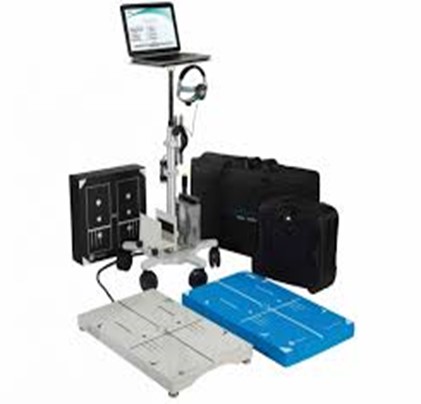This paper was submitted as part of Dr. Pielick's application for ACOFP Fellowship, which recognizes exceptional national, state, and local service through teaching, authorship, research, or professional leadership. Visit the ACOFP Fellows page to learn more about fellowship and the nomination process.
ABSTRACT
This study focuses on using clinical tests with the help of the VSR sport system to assess the concussions sustained by girls and boys’ varsity and junior varsity soccer players during the school soccer season. VSR sports has been used in different studies to assess balance after a concussion. This study sought to examine the utility of two clinical tests available in the VSR sport system, modified clinical test of sensory interaction in balance (mCTSIB) and limits of stability (LOS), in the assessment of concussion.
Objectives: To compare pre-, mid- and post-season analysis of mCTSIB and limits of stability (LOS) of varsity and junior varsity soccer players (boys and girls) using VSR sport system.
Methods: The study was done at local high school using subjects who were varsity and junior varsity soccer players. A one-way analysis of variance (ANOVA) test was chosen as the data contained continuous response variables.
Results: There is a statistically significant change between reaction times and maximum velocity on the Limits of Stability Test between pre, mid, and post season results based on a 95% confidence level.
Conclusion: mCTSIB and LOS using VSR sport can be reliable balance tests for establishing baseline values in the absence of concussion in young athletes during the season. The results of the study were significant to show normative values for young soccer athletes over the course of a season without injury. Concussion can result in decreased reaction time and lower scores on the mCTSIB. Future studies could look at whether practice on the VSR-Sport system can improve athletes’ performance on these tests.
INTRODUCTION
An estimated 300,000 sport-related concussion injuries occur in the United States annually (Gessell et al. 2007). Approximately 30% of individuals with concussions experience balance disturbances. No single tool can fully quantify a concussion injury. (McCrory et al. 2005, 2012). Yet measures that focus on the most prevalent symptoms experienced by individuals after a concussion injury could help in diagnosis. The most common symptoms are headaches, dizziness, and balance problems. (McCrory et al. 2005, Guskiewicz et al. 2001) Of the 3 top symptoms, dizziness and balance dysfunction are related. Thus, examining balance dysfunction after a concussion could provide a quantitative, objective measure of the injury. While most concussion resolve within 48-72 hours, it may cause mild traumatic brain injury which can lead to irreversible changes in brain tissues. There are a lot of clinical tests available for Balance assessment due to concussions occurred during the season. Common methods of balance assessment include the Clinical Test of Sensory Organization and Balance (CTSIB), the Sensory Organization Test (SOT), the Balance Error Scoring System (BESS), and the Romberg test. The National Collegiate Athletic Association also recommended the Wii Fit as an alternative measure of balance in athletes with a concussion.
The CTSIB was originally developed by Shumway-Cook and Horak in 1986 and involves 6 major scenarios that systematically remove or conflict sensory inputs. The modified CTSIB, which involves more technically complex equipment measures such as a force platform, is used more commonly in research. The assessment procedures for the CTSIB, regardless of modification, include the following phases: alternating between standing on high-density foam or the ground, with eyes open, closed, or looking into an object. Balance is measured using a scale of 1 to 4: a lower value indicates the least amount of postural sway, and a value of 4 indicates the potential for falling. However In a recent study Guskiewicz et al ( 2011) administered the modified CTSIB and found that participants with concussions had decreased postural stability compared with baseline scores during the initial 3 days after injury. These results suggest that the balance deficits were related to sensory integration interaction errors indicating that CTSIB is a valuable tool for baseline balance testing and post injury assessments to distinguish symptomatic versus non symptomatic athletes prior to their return to play decisions.
VSR sports is an instrument designed to use these clinical tests to provide objective information on the balance dysfunction in case of concussion. The most common tests used in VSR Sport are MCTSIB, LOS, and rhythmic weight shifting. The VSR system was developed by Neurocom and includes a force plate connected to a podium with a laptop screen adjusted to subject’s eye level. It is able to test patient’s weight shift and center of gravity. See Figure 1 for a picture of VSR Sport.
This study sought to use two of the most common tests (mCTSIB and LOS) in clinical settings to assess the concussion sustained during the soccer season.
Figure 1

METHODS
Subjects
This research project was a prospective study, within subject design to help rehabilitation and medical professionals understand effective methods of testing concussion as it relates to history of concussion in varsity and junior varsity soccer players. Initial testing occurred over two days, after school, and before the first regular season game for each team. Subjects were recruited through flyers in school locker rooms reminding athletes to acquire parental consent if desired to participate. Once consent was obtained, subjects were tested in the locker room, one at a time. Prior to testing, participants filled out a short survey (see Appendix 1 for Pre-Questionnaire) to provide information on their history of concussions or other head-related injuries. This was administered prior to pre, mid and post-season testing.
Subjects included healthy athletes cleared for participation in junior varsity and/or varsity soccer. Appropriate approval for this project was obtained from the school administrator and the Director of the Athletic Department and the School Board. Total participants included forty-four junior and varsity student athletes, including seventeen varsity girls, thirteen junior varsity girls, six junior varsity boys, and eight varsity boys. Mean age of the Boys who participated was 16.01 years of age. Mean age of Girls who participated was 15.65 years of age. In order to participate in the study, all participants or their legal guardian had to sign a consent form (see Appendix 1). Subjects had to be healthy adolescent athletes cleared by their primary physician for participation in junior varsity or varsity sports, of both male and female gender. Individuals excluded from the study were those within 48 hours of an acute concussion, those with current lower extremity injury; history of serious cognitive impairment, or traumatic brain injury not related to sports (i.e. Asperger’s, motor vehicle accident, cerebral palsy, etc.). However, there was one outlier who was tested that had an MVA less than one year prior to testing.
DATA COLLECTION
Risks
One potential risk was the emotional stress that could occur if the VSR Sport detected a neurocognitive deficit of which the test subject was previously unaware. There was risk of breach of confidentiality, simply due to the number of individuals involved in the project. To minimize the first risk, each investigator presented test findings in a calming, reassuring manner, and recommended follow up with his or her primary physician. To minimize the second risk, individuals were tested one at time, data was not shared between subjects by testers. Each subject was given an identification number that did not reveal any personal information. Another risk to the subjects was a possible fall as their balance was being tested. To address this, testers stood in close proximity to the subjects and provided assistance as needed.
Procedure
To ensure consistency between subjects and previously performed research, participants were asked to remove their shoes and socks. Investigator entered the subject’s data into VSR Sport Database.
Testing began by the participant stepping onto the metal platform/force plate connected to the VSR Computer Software System. Subjects were instructed to position their feet so that their medial malleoli were directly over the horizontal line and heels completely covering the three shorter lines on the force plate. The VSR screen prompted the participants as to where they should position their feet and assistance was provided by the tester to ensure the correct position. The Modified Clinical Test for Sensory Interaction on Balance (mCTSIB) was performed first. This test collected data on the body systems that controls balance (vestibular, somatosensory, and visual systems). The mCTSIB included three trials under each of the following conditions: 1) firm surface with eyes open, 2) firm surface with eyes closed, 3) foam surface with eyes open, 4) foam surface with eyes closed. Between the second and third conditions, subjects stepped off the platform, and investigator placed a standard foam issued with the computer system. The participant then stepped back onto the foam with identical positioning as on the firm surface.
The second test performed was the Limits of Stability Test, which assessed how far the subject could control his or her center of gravity outside his or her base of support on a firm surface. Subjects stepped onto the metal platform in the position prompted by the VSR sports system screen. He or she had one attempt to move the cursor, which was linked to their center of gravity, towards eight different boxes, highlighted in a clockwise direction on the computer screen. Subjects are given 15 sec to reach the target each time.
Questionnaire, data entry, and testing took approximately seven minutes to complete for each subject. Following completion of both tests, all applicable surfaces were disinfected prior to the start of testing for the next subject. This process was repeated half-way through the season with the Mid Season Questionnaire (see Appendix 1 for Mid Questionnaire). After the last game of the 2016 soccer season, the above process was again repeated using Post Season Questionnaire (See Appendix 1 for Post Questionnaire). The outcome measures collected included the velocity of movement and the degree of sway as detected by the VSR sport in reference to each subject’s center of gravity.
Analysis
The data collected was then analyzed by Centra Analytics Team at Centra Health. The best method for analysis was determined to be a one-way ANOVA. The sample size was 44 participants. Outcome measures were 1) subjects’ “degree of sway” and 2) the “velocity of movement” of his/her center of gravity, as recorded by the VSR Sport Computer Software system, during the different testing scenarios.
RESULTS
The mean composite score for mCTSIB was not significantly different during the pre, mid and post season analysis.
The mean reaction time composite (RT-C) was significantly different between each testing session. This value decreased from pre-season to mid-season, and then further decreased from mid-season to post season. Maximum velocity composite (MXL-C) score was significantly increased from pre-season testing to mid-season testing and further increased from mid-season to post season testing. End point excursion (EPE) was significantly increased from pre-season to mid-season testing, however it decreased from mid-season to post season. Maximum Excursion Composite (MXE-C) score was not statistically significant between pre, mid or post season. Directional control composite (DCL-C) was also not statistically significant between the testing sessions.
There was one subject who sustained two concussions during the testing process. He experienced one concussion between pre- and mid-season testing and another between mid- and post-season testing. This subject demonstrated a decrease in mCTSIB composite scores from 0.8 to 0.7 between pre- and mid-season testing. The mCTSIB score then decreased to 0.6 during post season testing. Additionally, this subject’s LOS Reaction Time Score increased from Pre- to Mid-season and then decreased from mid to post season. His Maximum Velocity score increased over time for all three testing sessions.
CONCLUSIONS
The lack of statistical difference between pre, mid, and post season scores on the mCTSIB suggests that normally functioning young athletes do not have a change in scores over the season. This suggests learning the test did not affect the test result. The presence of a change in an individual may suggest the presence of injury and/or concussion. In the absence of concussion there should be no significant change between mCTSIB test scores over time. However, the statistically significant improvement in LOS test scores of the specific data points described above suggests multiple possibilities. The individuals may have improved simply from the repetition and practice of testing. Therefore, it can be assumed that the longer athletes participated in soccer, the better their reaction times and movement velocity scores would be on the LOS. It is hypothesized that prolonged participation in sports improves reaction times and movement velocity in the absence of a concussion.
There was no significant difference between subjects who had a history of a concussion versus those who did not had the history of a concussion. However, as mentioned in the results, one subject did have multiple concussions during the season which resulted in worse scores for mCTSIB and LOS tests.
DISCUSSION
Results from this study were not indicative of significant difference in the subjects who sustained concussions versus those who did not. However, mCTSIB testing using VSR sport system can be a useful tool for screening the athletes who sustain concussion during the soccer season. There was one subject who had two concussions during the season whose scores did change instead of remaining consistent. This suggests that having a concussion may result in impaired sensory integration (mCTSIB) and increased reaction times on the LOS. Future studies using a randomized controlled trial can explore this assumption. In future we would like to see a higher sample size of those athletes who have had a concussion and those who have not.
Since testing alone demonstrated an improvement over time in the average results on LOS scores in athletes, training on the VSR Sport System could improve scores on the LOS even significantly more than this study illustrates. VSR Sport may be a useful tool for training young athletes to improve their reaction time to visual stimuli and/or their movement velocity. Future research could look at these factors and identify whether training on VSR-Sport can improve young athletes’ overall performance. Even if not statistically significant, research data collected through this study will help shape future studies on the subject material, and possibly identify presence of concussion where it would otherwise remain undetected. To explore implications of the results of this study, we would suggest future research that includes multiple sports and multiple schools across different geographic locations.
Limitations to This Study
Not all participants completed all three testing sessions. Eighteen subjects did not participate in the post-season testing and therefore could not be included in the post season analysis for either the mCTSIB or LOS. Study sample size was less than sixty meaning there was less power and smaller changes between data points. A larger sample size would likely create larger differences (if any) and improve power of the study. Higher reliability of these tests would also be established with a larger sample size. Inter-rater reliability was limited second to multiple testers performing the test on subjects. Another limitation would be that these tests are limited in their ability to test all brain processes that may be affected by mechanism of injury from a sustained concussion. Even though the raw data was used for analysis, the VSR Sport in-test parameters were calibrated for adults aged 18-24 years and not for high school aged athletes. The age group being tested did not have normative data against which comparisons could be made. This study was done with one sport in one high school in a rural setting.
REFERENCES
Gessel, Luke M, Sarah K Fields, Christy L Collins, Randall W Dick, R. Dawn Comstock, Concussions Among United States High School and Collegiate Athletes. J Athl Train. 2007; Oct-Dec; 42(4): 495–503.
Guskiewicz KM. Balance assessment in the management of sport related concussion. Clin Sports Med. 2011;30(1):89–102, ix.
Guskiewicz KM, Mihalik JP, Shankar V, et al. Measurement of head impacts in collegiate football players: relationship between head impact biomechanics and acute clinical outcome after concussion. Neurosurgery. 2007;61(6):1244–1252.
Guskiewicz KM, Ross SE, Marshall SW. Postural stability and neuropsychological deficits after concussion in collegiate athletes. J Athl Train. 2001;36(3):263–273
McCrory P, Johnston K, Meeuwisse W, et al. Summary and agreement statement of the 2nd International Conference on Concussion in Sport, Prague 2004. Br J Sports Med. 2005;39(4): 196–204.
McCrory P, Meeuwisse W, Aubry M, et al. Consensus statement on concussion in sport: the 4th International Conference on Concussion in Sport held in Zurich, November 2012. J Sci Med sport. 2013; 16(3):178–189.
Shumway-Cook A, Horak FB. Assessing the influence of sensory interaction of balance: suggestion from the field. Phys Ther. 1986; 66(10):1548–1550.





